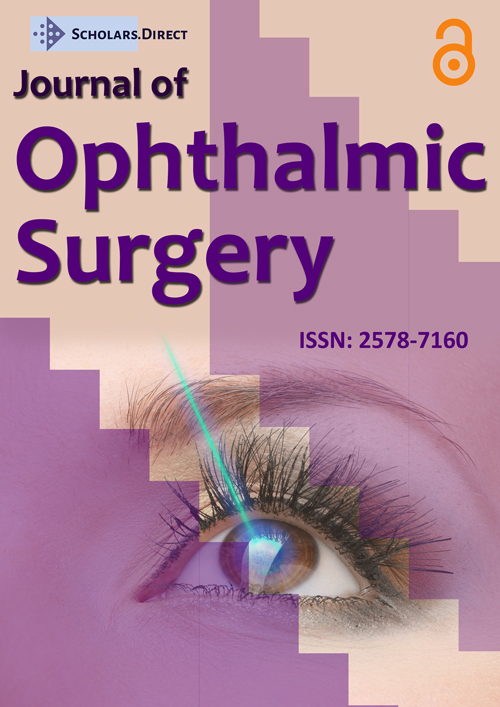The Cost-Effectiveness, Cost-Utility, and Ecological Impact of a New Immediate Sequential Bilateral Cataract Surgery Method
Abstract
Purpose : To determine the cost-effectiveness, cost-utility, and ecological impact of a new immediate sequential bilateral cataract surgery (ISBCS) method, in which both eyes are operated on in one procedure using the same protective clothing and coverings.
Setting : A retrospective comparison was conducted in western Finland, involving operations performed in one public hospital and two private hospitals, as well as a university hospital.
Design : Retrospective cohort study.
Methods : Data from 6698 patients (11453 eyes) were examined. Three cohorts were analysed. The new ISBCS method cohort (2328 patients/4656 eyes) performed by one senior surgeon in both public and private hospitals, a traditional ISBCS control group (2427 patients/4854 eyes) in a university hospital, and a unilateral cataract control group (1943 patients/1943 eyes) by the same senior surgeon in a public hospital. Main outcomes measured included material costs, personnel costs, quality-adjusted life-year (QALY) costs, and carbon footprint.
Results : Compared with traditional ISBCS and unilateral control groups, the new ISBCS method resulted in a 24.6% reduction in total costs per eye and a 28.6% reduction in personnel costs per eye. The new ISBCS method lowered QALY-cost by 24.6% and was also estimated to reduce the carbon footprint per eye by 29.2% compared to traditional ISBCS.
Conclusions : This new method of performing ISBCS can potentially improve surgical productivity, reduce per-eye costs, lower QALY-cost, and significantly decrease carbon footprint, without compromising patient safety. It could thus serve as a preferred protocol for ISBCS in the future.
Introduction
Traditional immediate sequential bilateral cataract surgery (ISBCS) remarkably improved cataract surgery in cost-effectiveness [1] and health benefits [2] compared to delayed sequential bilateral cataract surgery (DSBCS). It has been shown that ISBCS is 1.23 times less costly than DSBCS in Finland [3], which inspires us to find out further cost-savings possibilities within the realm of cataract surgery. We have developed a new method of ISBCS to combat this objective. The key difference in this new method compared to traditional ISBCS is the phacoemulsification and cataract extraction of the patient’s both eyes in one operation [4]. This means that the procedure and coverings for both eyes will be prepared once, and protective clothing is not changed between each eye. Therefore, it could be expected that time and materials will be saved, which will potentially lead to more operations per day and fewer materials to be used. This would also imply higher productivity. As the studied new method to perform ISBCS has been shown to be non-inferior in safety compared to traditional ISBCS [4], we can now start to investigate its cost-effectiveness and environmental effects. The efficient targeting of resources and finances in public health care is extremely important in today’s world, as these are seemingly scarce [5-8]. Furthermore when global warming is taken into account, ways to decrease carbon emissions and waste during cataract surgery are equally important to investigate [9-14]. The aim of this study is to determine the cost-effectivity, the cost-utility and the ecological aspects of this new method of performing ISBCS compared to the traditional way of performing ISBCS and to unilateral cataract operations on a national level. We expect this new method to offer better cost-effectiveness and cost-utility in terms of operations per day and operational cost compared to current accepted methods. This premise is assessed by exploring procedure times, labor, property, and material cost. There are currently no cost-effectivity, cost-utility, or ecological studies conducted on simultaneous phacoemulsification and cataract extraction of both eyes using the same protective clothing and covering under one operation.
Methods
This retrospective study compared the cost-effectivity, the cost-utility, and the ecological aspects of simultaneous phacoemulsification and cataract extraction by the studied method for ISBCS to traditional ISBCS and to unilateral cataract operations done in western Finland. This study was approved by the ethics committee and followed the tenets of the Declaration of Helsinki. Ethical approval was not required for this study in accordance with the ethical review that had been performed by the Ethics Committee for Human Sciences at the University of Turku.
The study group consisted of ISBCS operations performed between 25.8.2009 and 11.12.2019 by one senior surgeon. Operations in the study group were done at one public hospital and at two private hospitals. The control groups were those traditional ISBCSs done at a university hospital by several senior surgeons between 1.1.2017 and 31.12.2018 and all unilateral cataract operations done by the same senior surgeon as in the study group at one public hospital between 25.8.2009 and 17.4.2019.
Data was retrieved retrospectively from the electronic or physical records of each hospital with permission being granted by the chief physician of the organization responsible for registries. The data collected comprised: the operation day, the patient’s age at the time of the operation, gender, type of intraocular lens inserted, the diagnoses of preoperative risk factors (International Classification of Diseases 10, ICD-10) or operation codes (NOMESCO Classification of Surgical Procedures, NCSP) or mentions in referrals, the operational timestamps available, intraoperative complications indicated by extra operation codes (NCSP), biometrical values in both eyes (keratometry min, keratometry max, axial length), preoperative refraction, preparation time before surgery, operation time, finishing time after surgery, and change time between patients.
The costs of materials were collected from the clinics where operations of this study were performed in Finland. The cost of labor was estimated from the latest Statistics Finland’s median earnings database [15].
The main outcome measures were the differences in direct material and personnel costs of the study group and bilateral control group. Only the direct costs were considered because these were the variables that were different between these cohorts. Secondary outcomes included possible differences in the costs of produced QALY between the study group and the bilateral control group and in the carbon footprint of the study group and the bilateral control group as well as the unilateral control group.
Statistical methods
Differences in implanted lens design and the patient’s sex were assessed with Fisher’s exact test. Differences in all other baseline characteristics of the cohorts and the durations of different peri-operational phases were assessed with two-sided unpaired t-tests. Statistical analyses of output and input costs, QALY-savings, and the carbon footprint were not feasible because the respective data were only available as cohort-wise aggregates rather than samples of operation-specific outcomes. The analyses were performed using SAS System, version 9.4 for Windows (SAS Institute Inc., Cary, NC, USA). P-values below 0.05 were considered significant.
Results
Baseline characteristics of the cohorts
A total of 6698 patients and 11453 eyes from three different cohorts were included in this study. The study group included in total 2328 (34.8%) patients and 4656 (40.7%) eyes respectively. The study group consisted of patients at one public hospital with 1286 patients and 2572 eyes respectively, and at two private hospitals with 576 and 466 patients and 1152 and 932 eyes respectively. The ISBCS control group consisted of patients at a university hospital with 2427 (36.2%) patients and 4854 (42.4%) eyes respectively. Lastly, the unilateral cataract operations control group consisted of patients at one public hospital involving 1943 (29.0%) patients and 1943 (17.0%) eyes. The baseline characteristics between these three cohorts were comprehensively evaluated. Despite that there were some statistically significant differences between cohorts, such as age, sex, implanted lens type, and properties of operated left eye (Table 1), these should have had no effect on material costs nor should have had a significant effect on clinical procedure times.
The mean preoperative risk factors per patient for each cohort were presented in Table 2. Although there were some statistically significant differences in preoperative risk factors between cohorts, these should have had no effect on material costs nor should have had a significant effect on clinical procedure times.
Intraoperative complications could have had an effect on the amount of materials used and procedure times. Our cohorts presented no statistically significant difference in mean intraoperative complications per patient between the study group and the ISBCS control group (p=0.45; t-Test), and between the study group and the unilateral control group (p=0.40; t-Test) (Table 3).
The mean operation time for the study group was 23.0 minutes, for the ISBCS control group was 47.0 minutes, and for the unilateral control group was 12.0 minutes (Table 1). There was a statistically significant difference detected in operation times between the study group, the ISBCS control group, and the unilateral control group (p<0.001; t-Test). Therefore, the potential time saving in operation times with the studied ISBCS-protocol for each eye could have been 12.0 minutes (51.1%) when compared to the ISBCS control group and 0.5 minutes (4.2%) when compared to the unilateral control group. It was worth emphasizing that the whole mean operation time for the unilateral control group was only for one eye, while the whole mean operation time was for both eyes in the other groups.
Duration of different peri-operational phases
The time for peri-operational phases consisted of change time between patients, preparation time before surgery, and finishing time after surgery. We only compared the study group with the ISBCS control group, as the ISBCS control group was our focus for improvement in terms of the operation time. Peri-operational phases were expected to be mainly constant across cohorts. The median change time between patients was 6.0 minutes (Table 4) in the study group. We deduced that the same change times between operations applied to the control groups. The study group was also missing data on change times (n=1459, 45.2%), since this data was not fully provided by the clinics. This might have been important, as change times were not completely equivalent between the private and public sector. There could have been doctor’s appointments between operations in the private sector, which might have skewed operational change times. Taking these factors into consideration led to the conclusion that no comparison on change times between patients could be made between given groups. Therefore, mean change times gave only direction on how many operations could be done in one workday.
The median preparation time before surgery was 15.0 minutes for the study group and 16.0 minutes for the ISBCS control group (Table 4). The median finishing time after surgery was 5.0 minutes for the study group and 4.0 minutes for the ISBCS control group (Table 4). There was a statistically significant difference both in preparation and median finishing times between the study group and the ISBCS control group (p<0.001; Chi-Square).
Output and input costs
The total material costs for each eye were 154.0 € in the study group and 196.8 € for the ISBCS and unilateral control groups (Table 5). The breakdown of costs was presented in Table 5. As shown, the possible saving in material costs only per eye was potentially 42.8 € (21.8%) with the new method for ISBCS in the study group compared to ISBCS and unilateral control groups.
Direct personnel costs were billed by hour. The number and types of personnel needed to perform the procedure were the same across all cohorts. An average workday was estimated to be 7.65 hours in Finland. This indicated that the total direct personnel cost of 1373.8 € per day [15] was the same across different cohorts. However, real-life best possible volumes per day differed between cohorts because of different operation and peri-operational times. Within 6.0 hours of effective time per day, it was possible to operate on 14 eyes in the study group and 10 eyes in ISBCS and unilateral control groups (Table 5). As a result, real-life personnel costs per eye were 98.1 € for the study group and 137.4 € for the ISBCS and unilateral control groups (Table 5). Consequently, the possible cost saving in personnel costs per eye was potentially 39.3 € (28.6%) with the study group using the new ISBCS method compared to ISBCS and unilateral control groups (Table 5).
The total cost of material and personnel per eye added up to 252.1 € for the study group and 334.2 € for ISBCS and unilateral control groups (Table 4). Hence, the total cost savings in material and personnel costs per eye potentially added up to 82.1 € (24.6%) with the new method in the study group compared to traditional ISBCS and unilateral control groups (Table 5).
QALY-savings
We determined possible QALY-savings from the differences in material and personnel costs between cohorts. The QALY-gain of bilateral cataract operation for men between 60-62 years was 0.31 and for women of the same age was 0.35 (Table 6). The QALY-gain of bilateral cataract operation for men between 80-82 years was 0.14 and for women of the same age was 0.16. Since the percentage of women in the study group was 62.5% and for men 37.5% respectively, we calculated a common QALY for sexes: 0.625×0.16 + 0.375×0.14 = 0.1525. As a result, cost per QALY was 1653.1 € for the study group and 2191.2 € for the ISBCS control group. Thus, the QALY-cost was potentially reduced by 538.1 € (24.6%) with the new ISBCS method in the study group compared to the ISBCS control group.
The carbon footprint of different methods
In a study conducted in Wales, Cardiff in 2013, it was found that the total carbon footprint of cataract surgery for one eye was 181.8 kg carbon dioxide equivalents (CO 2 eq) [9-14]. The breakdown of the total carbon footprint was presented in Table 7. We assumed that the population and geography in Wales were representative of the population and geography in Finland in terms of cataract surgery. Resultantly, we used these results to estimate the carbon footprint for traditional ISBCS and the new ISBCS method per eye. Traditional ISBCS for both eyes could be thought of as two unilateral operations, as everything was prepared again before continuing to the second eye. Hence, the ISBCS control group in our study and the study in Wales could be thought to have the same carbon footprint per eye. With the new ISBCS method, the carbon footprint per eye was possibly reduced to 128.7 kg CO 2 eq (Table 7). This resulted in a potential carbon footprint reduction of 53.1 kg CO 2 eq (29.2%) per eye compared to the ISBCS control group (Table 7).
Discussion
The aim of this study is to determine the cost-effectivity, the cost-utility and the ecological aspects of the studied ISBCS method compared to traditional ISBCS and to unilateral cataract operations on a national level. The results indicate a clear advantage of the new ISBCS method over traditional ISBCS in terms of cost-efficiency and cost-utility, as well as in QALY-cost and carbon footprint.
The study group and the ISBCS control group compare well demographically and show no statistically significant difference in terms of age and sex between these cohorts. This adds to the statistical power of this study and allows for stronger comparison between outcome measures.
The new ISBCS method is able to provide time saving with shorter operation time, which leads to more operations per day and therefore is able to increase cost-effectivity. It is important to note that while the pure operation time for the new ISBCS method (23.0 min) is longer than for the unilateral control group (12.0 min), the new method covers the operation of both eyes rather than just one.
The new ISBCS method offers small time changes in peri-operational phases compared to the ISBCS control group. Although the difference in median preparation and finishing times is statistically significant, the overall time saving is zero and does not offer benefits in the time taken for peri-operational phases. This indicates that the main time-saving aspect is provided by the new method and procedure itself.
The new method for ISBCS is able to provide an important overall cost saving per operated eye compared to traditional ISBCS and unilateral control groups. With the use of the new ISBCS method, it is possible to have a 24.6% decrease in total cost per operated eye compared to traditional ISBCS and unilateral control groups. In 2023 alone this cost saving could have added up to roughly 8,200,000 € in Finland on a national level [16] when calculated using the data of this study. With the current lack of economic resources in public health care [5-8], this saving is surely well welcomed. Correspondingly, the decrease in QALY-cost is important to note from a medical and economic standpoint [5-8].
Besides patient safety and economic responsibility, it is important to take carbon footprint into consideration. Less materials are used per operation, which shows a clear saving in materials costs that in return increase cost-utility and reduce carbon footprint.
With the new ISBCS method, 172 trees [12,17] would need to be planted for every 1000 eyes operated in order to be carbon neutral in Finland. Correspondingly, with traditional ISBCS the number of trees needed to plant for every 1000 eyes operated would be 242 [12,17] in order to be carbon neutral. When the current state of climate change is considered, it is preferable to perform cataract surgeries with the new ISBCS method over traditional ISBCS [9-14]. Improvements in cataract surgery protocols, as with the new ISBCS method, can provide a remarkable difference in the carbon footprint of a clinic annually [9-14].
Major strengths of this study include cohort sizes that are large enough to provide reliable information and statistical power to calculations and results. Additionally, real-life data for costs of personnel and materials have been used to conclude potential cost savings between the study group and control groups. This data represents accurately the potential cost savings achievable and applicable in Finland.
One of the weaknesses of this study is the difficulty to compare the time of peri-operational phases between public and private clinics. This difficulty is mainly caused by differences in schedule structures between public and private clinics. Another weakness of this study is the presence of a statistically significant difference between the study group and ISBCS control group in regard to implanted lens design, mean AL of the left eye, mean keratometry, mean preoperative refraction SE, and mean preoperative risk factors. The effect of these statistically significant differences in cohort demographics on main or secondary outcome measures has not been studied.
Beauchamp has suggested the concept where physicians should create both patient value and economic value [18]. Reduced overall procedure cost, QALY-cost, and carbon footprint while maintaining patient safety [4] all support the utilization of the new ISBCS method in the future. With this in mind, we advocate the application of the new ISBCS method as a standard and improvement over ISBCS in situations where applicable. To prove this motion, more research is required on the topic.
Acknowledgments
Conflict of interest : The authors have no financial disclosures.
Financial Support : The corresponding author has received grants from the University of Turku (2500€) and Medical foundation of Vaasa (4500€) to perform PhD-studies. These sponsors have not had any influence on the study. The third author has been paid a normal salary for his effort by his employer the Turku University Hospital, which again has charged this amount the corresponding author. The last author has not had any financial support.
References
- Lansingh Van C, Kristen A Eckert, Glenn Strauss (2015) Benefits and risks of immediately sequential bilateral cataract surgery: A literature review. Clin Exp Ophthalmol 43: 666-672.
- Leivo T, Sarikkola AU, Uusitalo RJ, Hellstedt T, Ess SL, et al. (2011) Simultaneous bilateral cataract surgery: economic analysis; Helsinki Simultaneous Bilateral Cataract Surgery Study Report 2. J Cataract Refract Surg 37: 1003-1008.
- O’Brart David P, Harry Roberts, Khayam Naderi, Jack Gormley (2020) Economic modelling of immediately sequential bilateral cataract surgery (ISBCS) in the National Health Service based on possible improvements in surgical efficiency. BMJ Open Ophthalmol 5: e000426.
- Janne J Järvenpää, Bernd Pape, Eija Vesti (2003) Simultaneous bilateral phacoemulsification and cataract extraction - A new operation method. Journal of Ophthalmic Surgery 6.
- Donaldson C, Magnussen J (1992) DRGs: The road to hospital efficiency. Health Policy 21: 47-64.
- Magnussen Jon (2009) Nordic Health Care Systems: Recent Reforms and Current Policy Challenges. Open University Press.
- Saltman RB (1990) Competition and reform in the Swedish health system. Milbank Q 68: 597-618.
- Schmid Achim, Mirella Cacace, Ralf Götze, Heinz Rothgang (2010) Explaining health care system change: Problem pressure and the emergence of ‘Hybrid’ health care systems. J Health Polit Policy Law 35: 455-486.
- Morris D, Wright T, Somner J, A Connor (2013) The carbon footprint of cataract surgery. Eye 27: 495-501.
- Ferrero A, Thouvenin R, Hoogewoud F, Marcireau I, Offret O, ey The carbon footprint of et al. (2022) surgery in a French University Hospital. J Fr Ophtalmol 45: 57-64.
- Taboun OS, Orr SMA, Pereira A, Choudhry N (2023) Factors contributing to the carbon footprint of cataract surgery. J Cataract Refract Surg 49: 759-763.
- Latta M, Shaw C, Gale J (2021) The carbon footprint of cataract surgery in Wellington. N Z Med J 134: 13-21.
- Winklmair N, Kieselbach G, Bopp J, Amon M, Findl O (2003) Potential environmental effect of reducing the variation of disposable materials used for cataract surgery. J Cataract Refract Surg 49: 628-634.
- Khor HG, Cho I, Lee KRCK, Chieng LL (2020) Waste production from phacoemulsification surgery. J Cataract Refract Surg 46: 215-221.
- Suomen virallinen tilasto (SVT): Kuntasektorin palkat (2018).
- Tulostaulukko, Kaihileikkaukset. Tulostaulukko - Sotkanet.fi, Tilasto- ja Indikaattoripankki.
- Hiilensidonta-Demo. UPM Forest Life.
- Beauchamp GR (2006) Physicians and nurses are economic value producers. Evidence Based Ophthalmology 7: 57-58.
Corresponding Author
Janne J Järvenpää, University of Turku, Silmäsairaala Pilke, Vaasanpuistikko 17, 65100 Vaasa, Finland.
Copyright
© 2025 Yang BM, et al. This This is an open-access article distributed under the terms of the Creative Commons Attribution License, which permits unrestricted use, distribution, and reproduction in any medium, provided the original author and source are credited.




